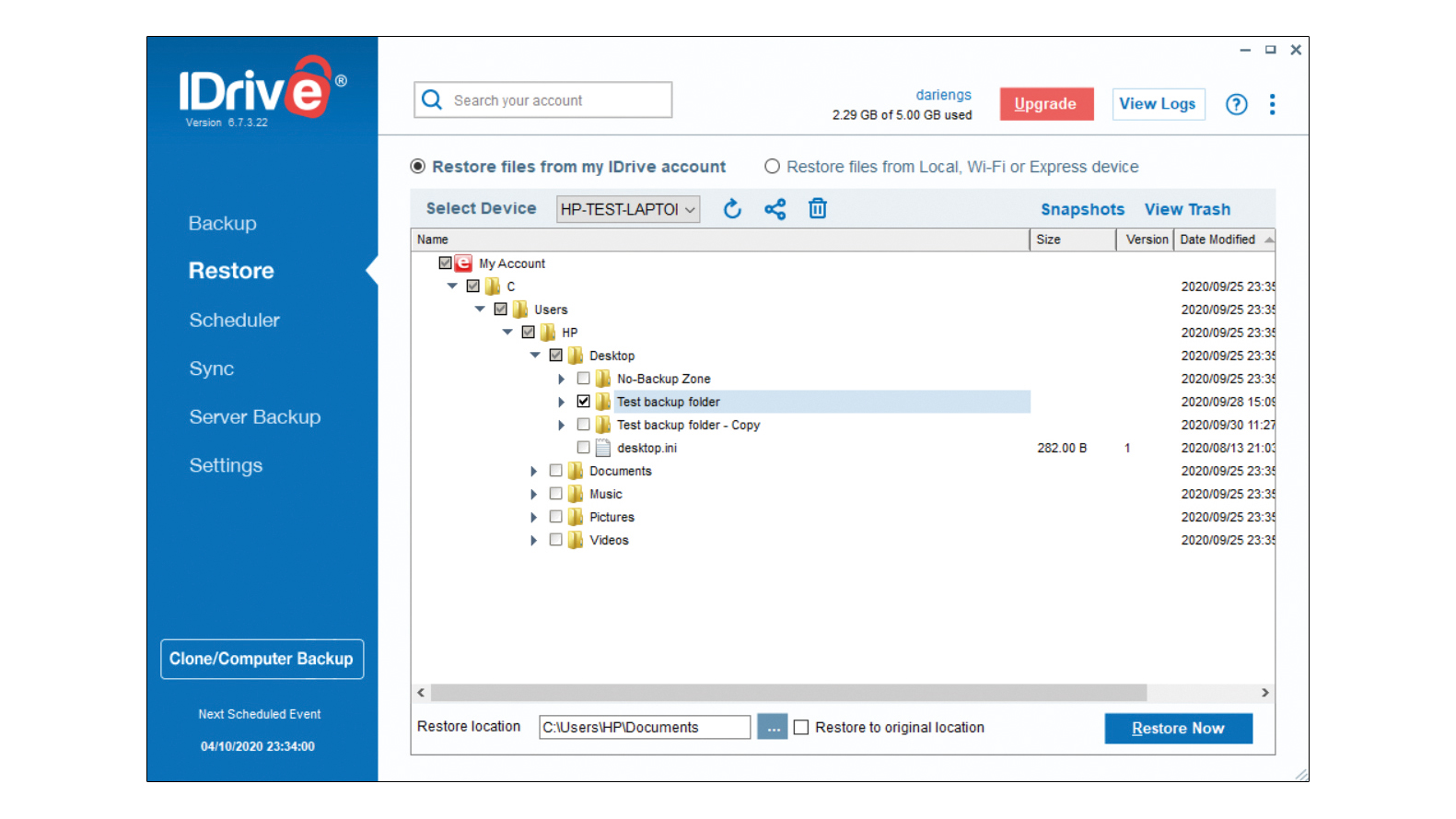IDrive Personal review: Set it and forget it
This cloud service is good value and easy to use – and it can take care of your local backup needs too


-
+
Server backup capabilities included
-
+
Supports local backup
-
+
Generous storage limit
-
-
Limited local backup features

If you’re looking for visual polish in your backup client, you may want to avoid IDrive’s service; the desktop client isn’t exactly ugly, but it looks like it was put together by a programmer rather than a professional designer. However, it makes up for this with an admirable focus on functionality: nearly all of its tools are accessible directly from the main window, via an obvious button with a clear text label.
It helps that IDrive isn’t overloaded with features. It’s first and foremost a cloud backup system, and that means the specifics of backup strategies, compression and so forth are handled invisibly by the service. Indeed, once you’ve chosen which files and folders you want to back up, IDrive immediately starts quietly uploading them without asking any further questions at all. Even multi-computer deployments are effortless to set up: simply install a second copy of the software on a Windows PC or Mac and IDrive will then automatically create a separate archive within your cloud account for that device.
If you prefer to take a more hands-on approach, there are a few settings you can tweak, including the backup scheduler. By default, IDrive continually watches your nominated backup folders and uploads all modified files smaller than 500MB as soon as changes are detected, with a full backup every day. You can change the frequency of (as well as disable) both processes; there’s no option to perform a full backup less often than once a week, but you arguably shouldn’t be backing up that infrequently anyway.
As is usual in cloud backup software, you can also exclude specific files and folders from your selection, as well as limit IDrive’s bandwidth and CPU usage to a percentage of your choice, and enable email notifications to confirm successful or failed backups. Really, though, that’s about it, and for everyday backups that’s probably all you’ll need. IDrive automatically stores up to 30 historical versions of modified files, and if you get low on cloud storage you can use the Archive Cleanup wizard to remove old files that are no longer present on your local hard disk – but we’d recommend that you use this with caution, as you could end up purging accidentally deleted files, leaving you with no way to recover them.
At any rate, you shouldn’t find yourself too short on space. The $52 annual subscription – equivalent to around £41 – gets you a roomy 5TB of storage in IDrive’s data centre, and while this is located the US, we found file transfers were surprisingly swift: our 2GB test archive zoomed across the Atlantic in 29mins 5secs, which was more than five minutes ahead of Carbonite. And if you’re worried about US agencies spying on your data, you can optionally specify your own private encryption key – subject to the usual warning that, if you lose it, there’s no way to recover your backed-up data.

If this were all that IDrive did, it would still be a decent choice for online backup. What distinguishes the program is that it also – unlike most other cloud backup services – supports local destinations. This means you can conveniently manage your on-site and off-site backups from one place, and set both to execute at whatever intervals you see fit.
Admittedly, the program’s local backup capabilities are rather limited. You can only create one local backup job, and the destination has to be the root directory of an internal, external or network drive (a subfolder named IDriveLocal is automatically created). You get exactly the same stripped-down set of options as you do when backing up to the cloud, which means that encryption and compression are always on. This has implications for performance: a full backup of our 2GB test folder was compacted down to 1.91GB, which is a decent saving, but it took 58 seconds to write to our USB 3 external drive. For subsequent runs, IDrive is smart enough not to re-copy unchanged files, but historical versions of files aren’t kept, nor can you set your own schema of full, incremental and differential backups.
Sign up today and you will receive a free copy of our Future Focus 2025 report - the leading guidance on AI, cybersecurity and other IT challenges as per 700+ senior executives
IDrive has a few other features worth mentioning. The sync tool lets you use your cloud storage as a sort of proto-Dropbox, automatically synchronising files across all computers with the IDrive client installed; you can also use IDrive’s web restore capability to easily grab individual files from wherever you happen to be. The Clone and Computer Backup button lets you make an image of your hard disk or operating system, which can be stored either locally or in the cloud and restored to the same PC or onto different hardware. For advanced users, there’s also a surprisingly sophisticated set of server backup options, which permit one-click data store backups from Microsoft 365, Hyper-V, SQL Server, VMware and more.
IDrive isn’t flexible enough to suit every role, but for small teams seeking set-and-forget protection, it could be just the thing: it’s very easy to set up, supports multi-computer installations and comes with enough storage to protect a whole team for a very reasonable price.
Darien began his IT career in the 1990s as a systems engineer, later becoming an IT project manager. His formative experiences included upgrading a major multinational from token-ring networking to Ethernet, and migrating a travelling sales force from Windows 3.1 to Windows 95.
He subsequently spent some years acting as a one-man IT department for a small publishing company, before moving into journalism himself. He is now a regular contributor to IT Pro, specialising in networking and security, and serves as associate editor of PC Pro magazine with particular responsibility for business reviews and features.
You can email Darien at darien@pcpro.co.uk, or follow him on Twitter at @dariengs.
-
 Return of the XPS: Dell resurrects iconic brand at CES after customer demand
Return of the XPS: Dell resurrects iconic brand at CES after customer demandNews COO says "branding matters" as Dell bucks trend at CES to bring back beloved XPS
By Bobby Hellard Published
-
 Microsoft CEO Satya Nadella wants an end to the term ‘AI slop’ and says 2026 will be a ‘pivotal year’ for the technology – but enterprises still need to iron out key lingering issues
Microsoft CEO Satya Nadella wants an end to the term ‘AI slop’ and says 2026 will be a ‘pivotal year’ for the technology – but enterprises still need to iron out key lingering issuesNews Microsoft CEO Satya Nadella might want the term "AI slop" shelved in 2026, but businesses will still be dealing with increasing output problems and poor returns.
By Ross Kelly Published
-
 These Microsoft Teams security features will be turned on by default this month – here's what admins need to know
These Microsoft Teams security features will be turned on by default this month – here's what admins need to knowNews From 12 January, weaponizable file type protection, malicious URL detection, and a system for reporting false positives will all be automatically activated.
By Emma Woollacott Published
